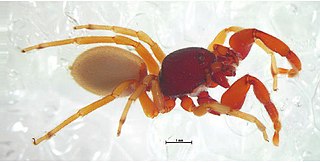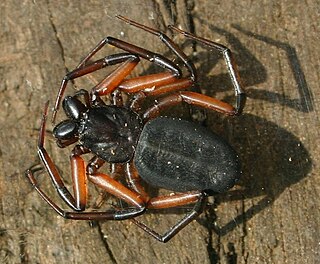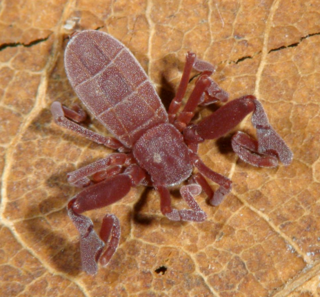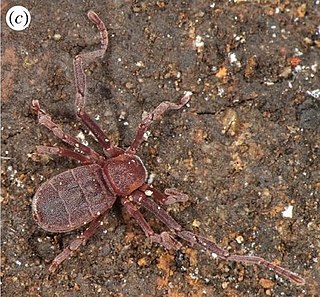
A gill is a respiratory organ that many aquatic organisms use to extract dissolved oxygen from water and to excrete carbon dioxide. The gills of some species, such as hermit crabs, have adapted to allow respiration on land provided they are kept moist. The microscopic structure of a gill presents a large surface area to the external environment. Branchia is the zoologists' name for gills.

Ricinulei is a small order of arachnids. Like most arachnids, they are predatory, eating small arthropods. They occur today in west-central Africa (Ricinoides) and the Americas as far north as Texas. As of 2021, 91 extant species of ricinuleids have been described worldwide, all in the single family Ricinoididae. In older works they are sometimes referred to as Podogona. Due to their obscurity they do not have a proper common name, though in academic literature they are occasionally referred to as hooded tickspiders.

Ground spiders comprise Gnaphosidae, the seventh largest spider family with over 2,000 described species in over 100 genera distributed worldwide. There are 105 species known to central Europe, and common genera include Gnaphosa, Drassodes, Micaria, Cesonia, Zelotes and many others. They are closely related to Clubionidae. At present, no ground spiders are known to be seriously venomous to humans.

Microstigmatidae is a small family of spiders with about 38 described species in eleven genera. They are small ground-dwelling and free-living spiders that make little use of silk.

Prodidomidae is a family of spider, sometimes called long-spinneret ground spiders. It was formerly regarded as a subfamily of Gnaphosidae, but was raised to a family in 2022.

Orsolobidae is a six-eyed spider family with about 180 described species in thirty genera. It was first described by J. A. L. Cooke in 1965, and was raised to family status from "Dysderidae" in 1985.

Palpimanidae, also known as palp-footed spiders, is a family of araneomorph spiders first described by Tamerlan Thorell in 1890. They are widely distributed throughout the tropical and subtropical regions of the world, the Mediterranean and one in Uzbekistan, but not Australia. They are not common and there is a high degree of endemism.

Symphytognathidae is a family of spiders with 90 described species in eight genera. They occur in the tropics of Central and South America and the Australian region. Exceptions include Anapistula benoiti, Anapistula caecula, and Symphytognatha imbulunga, found in Africa, Anapistula ishikawai, found in Japan, and Anapistula jerai, found in Southeast Asia.

Coneweb spiders (Diguetidae) are six-eyed haplogyne spiders that live in tangled space webs, fashioning a cone-like central retreat where they hide and lay eggs. It is a small family, containing only two genera split between a range in the Southwestern United States and Mexico and a range in South America. Members of the genus Diguetia usually build their webs in shrubs or between cactus pads. They have the same eye arrangement as the venomous recluse spiders, but none are known to be harmful to humans.

Platyoides is a genus of spiders belonging to the family Trochanteriidae. Its members are known as scorpion spiders and are found in sub-Saharan Africa and its islands, Madagascar, Réunion, Aldabra and the Canary Islands.
Losdolobus is a genus of six-eyed spiders found in Brazil belonging to the family Orsolobidae.

Nops is a genus of medium-sized South American, Central American, and Caribbean spiders in the family Caponiidae, first described by Alexander Macleay in 1839. It has a great richness on the Caribbean islands, and most mainland species are located in high proportion toward the Caribbean coast. It likely has a neotropical distribution, though most species of South America are known only from the coast of Colombia and Venezuela, including the islands of Aruba, Curaçao, Bonaire and Trinidad.

Cryptocellus is an arachnid genus in the order Ricinulei, first described by John Westwood in 1874. It is native to the Neotropics.

Pseudocellus is an arachnid genus in the order Ricinulei, first described by Norman Platnick in 1980. It is native to the Neotropics.

Pseudocellus pearsei is an arachnid species in the order Ricinulei. It occurs in caves in Yucatan, Mexico.

Cryptocellus goodnighti is an arachnid species in the genus Cryptocellus. It occurs in Costa Rica.

Cryptocellus becki is an arachnid species in the genus Cryptocellus. It can be found in the Amazon rainforest.
Amazoromus is a genus of South American ground spiders that was first described by Antônio Brescovit & H. Höfer in 1994.
Otiothops is a genus of palp-footed spiders that was first described by W. S. MacLeay in 1839.













